STH attended the AMD Computex 2017 press event today in Taipei, Taiwan. The company showed off three main strategic prongs: an update on EPYC the company’s server platform, continued consumer footprint expansion with Ryzen, and a release date for Vega its GPU.
AMD EPYC Gets a Launch Date
We will be covering the AMD launch but the company formally announced the launch date for its new chips, June 20, 2017.
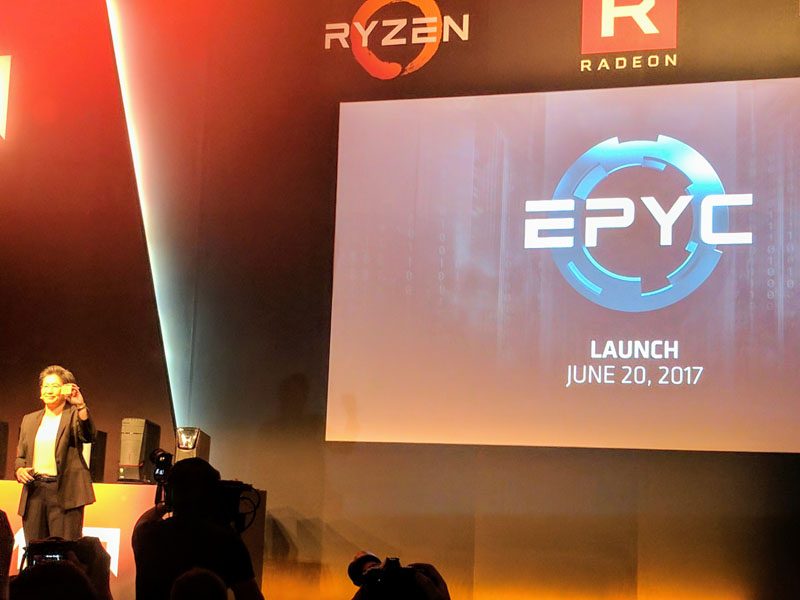
That is right, we are only about three weeks away from launch. While we cannot share the platforms we saw, we did see a few production ready server platforms from various vendors. One of AMD’s slides also showed off a single processor EPYC system motherboard:
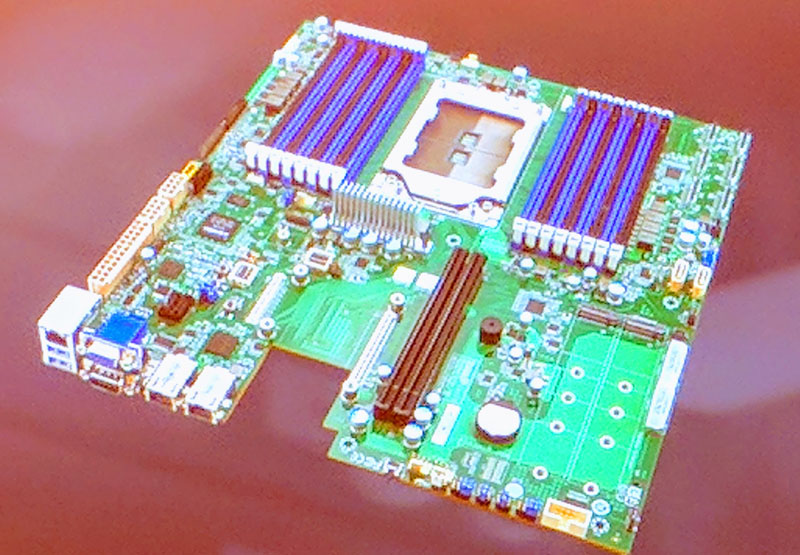
While we have seen several standard form factors from AMD and partners in the past (including their EPYC brand announcement), the standard ATX and EATX form factors really struggle with the 8-16 DIMMs per CPU and massive PCIe I/O of the Naples platform.
AMD Ryzen Threadripper and Ryzen Mobile
Perhaps the two worst kept secrets of today’s announcements were AMD Ryzen Threadripper and Ryzen Mobile. Threadripper is the high-end desktop platform that will compete with the Intel Core X and Core i9 series launched yesterday. Ryzen Mobile is AMD Ryzen CPU cores plus Vega graphics.
AMD Ryzen Threadripper
the AMD Ryzen Threadripper summary is this. Up to 16 cores/ 32 threads. 64 PCIe 3.0 lanes, quad channel DDR4 memory and the platform is called the X399, or a 100 increment over Intel’s X299 platform.
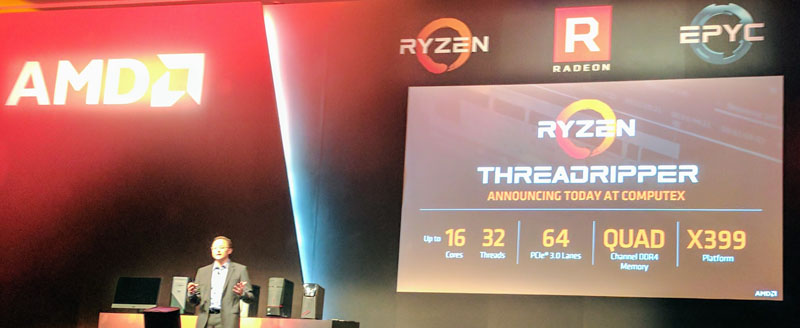
If you read our Core X series coverage, we were less than impressed with the PCIe culling Intel is using. Kudos to AMD for sticking with 64 PCIe lanes.
We were secretly hoping that AMD enabled the 10GbE NIC on its platform. Our informed opinion is that this should have 10GbE networking like EPYC. Perhaps that will come in a future update. For all those building high-end desktop PC’s, you will still need to save some PCIe lanes for a decent 10/25/40GbE NIC.
Ryzen Mobile
AMD showed off Ryzen Mobile in thin designs without sharing battery life. The company also showed off Ryzen in an ASUS gaming notebook with RX580 graphics. Here is the key slide:
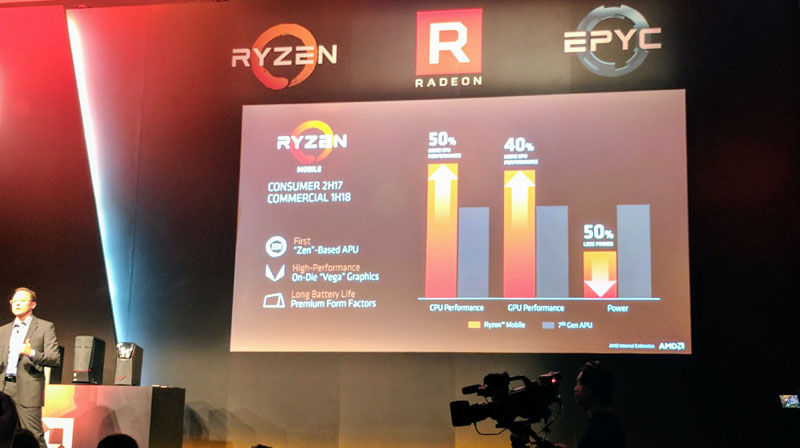
Our takeaway is that this may end up being a competitive APU but we are going to wait to see AMD’s delivery here. AMD is showing essentially a 3x CPU performance per watt gain.
AMD Vega Launching in Q2 Without Launching in Q2
When you have committed to launching your next generation GPU architecture in Q2 2017, but you are having HBM2 issues, what can you do? One option is to launch a high-end part that will be a lower volume part with only a few days left in the quarter. That is what AMD is doing with the AMD Radeon Vega Frontier Edition launching on June 27, 2017.
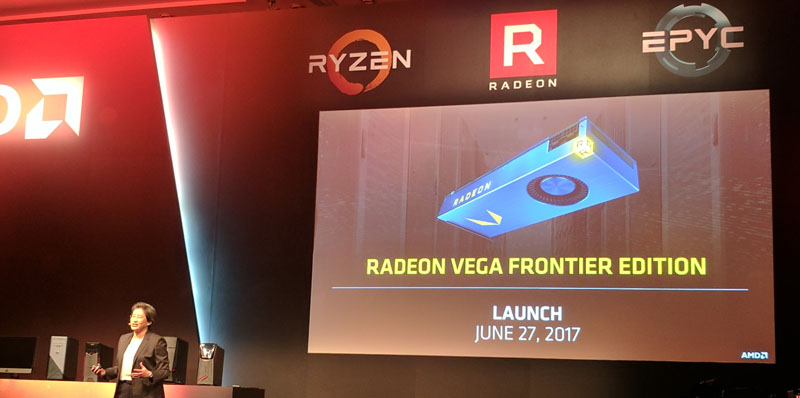
For those looking for a NVIDIA GTX competitor, the AMD Radeon RX Vega series will launch at Siggraph which runs from July 30 to August 3, 2017.
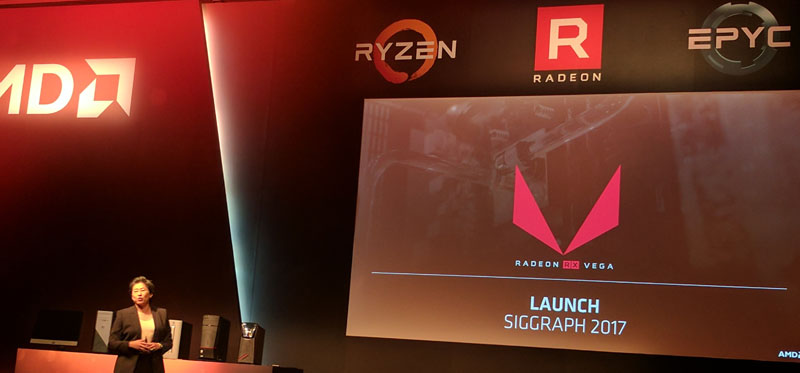
Note that these dates are launch dates and not availability dates.
Final Words
AMD has products which are truly differentiated. It is selling a message that is decentralizing the CPU’s importance and is instead showing the CPU as a quarterback to the rest of the system. For example, in the high-end desktop space, buy one CPU and four GPUs with 64x PCIe lanes. In the server space get more memory and more PCIe with EPYC for storage and GPU compute. That message is clearly different to Intel’s position that people are buying systems for CPUs.
While AMD has an interesting lineup, it needs to execute. Intel had a much stronger Core i9 launch timing than AMD Ryzen Threadripper. EPYC is coming soon, but what we can say from Computex is that we saw fewer EPYC systems than the further off Intel Scalable Processor family systems (to be expected since Skylake-SP has been shipping for many months to early access customers.) Vega is going to start life behind. NVIDIA is essentially on its second generation 1080 product with the 1080 Ti and has been shipping big Pascal for many quarters. By the time AMD ships RX Vega, the Volta hype cycle will begin and it is likely NVIDIA can match with GTX price cuts or clock speed bumps. The Vega Frontier edition shipping in Q2 (basically Q3) is going to run into Volta essentially starting to ship to high-value customers in Q3 as well (the kind that pay $15K/ GPU.)
AMD has a narrow window to start gaining market share and has a chance, but it needs to execute if it wants to succeed this year.

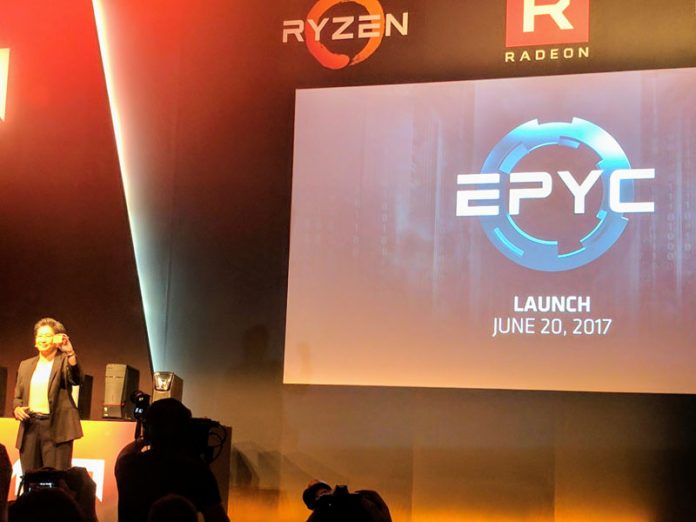



Any news on Supermicro supporting AMD Epyc?
We are under embargo/ NDA about specific vendor plans and platforms implementing EPYC. We will have a lot of coverage come release day.
“For all those building high-end desktop PC’s, you will still need to save some PCIe lanes for a decent 10/25/40GbE NIC.”
ASROCK do have the Acquantia 107 10Gbit single port onboard.
Although for heavier server builds then I would agree getting a Mellanox/intel card. Atleast 64 pci lanes is not holding you back that much. Otherwise EPYC could be interesting.
According to this article the corresponding 14, 16, 18 core parts from intel might not be available on market until 2018.
This suggests somewhat that intel was only going 12 core this year had it not had AMD waking up from its slumber.
http://wccftech.com/intels-skylake-x-core-i9-7980x-wont-be-available-until-next-year/
Yes fred, i had heard that also.
intel have only published clocks for the 12 core, suggesting higher core count cpuS may have to be downclocked considerably due to heat. IntelS is a more monolithic approach.
AMD circumvent this thermal, and many other problems, by demonstrably (ryzen) seamlessly linking multiple stock cpu & gpu processors on their MCM and fabric. They have proven 2x 4 core cpu units (zen cores) can combine well in ryzen, and very soon that 8x 4 core cpu units combine in Epyc.
Once they sort a gpu & cpu combo on an apu MCM, then the rest should be plain sailing for some exotic server oriented combos of processors, interconnected by 128 pcie3 lanes on the MCM/fabric.
We know raven ridge APU is 4 core & a vega core, and uses the am4 socket, so its the same MCM as ryzen – the 2 cores are similar size & can mix and match ~freely. i.e. 4 cores is interchangeable with one vega core.
If so, extrapolating to the Epyc MCM, a single ~epyc mcm could be 16 core & 4x vega gpu (~2x crossfires, or crossfired dual gpu cards – not much unfamiliar there), all interconnected cpu/gpuS on their own 128 lane fabric.
A further combo would be blocks of HBM2 vram in the space on the mcm otherwise used for a cpu or gpu core unit – on fabric ~500GBps vram – wow.
It seems very possible that even superior discrete gpu cards will be at a big disadvantage in c/gpu servers, (which seem the new black for serious perf gains).
Alternatively, AMDs slides show the full Epyc mcm filled w/ 32cores, and the Fabric branching to direct links to further cpu/gpu processors. As I said, vega can even have its own raid array for vast virtual vram on the 128 lane fabric. Its endlessly powerful.
So remarkably, not only are there 128 lanes for epyc, interconnects between multi cores, independently use a further 128 lanes, and place no load on the main pci bus, and is very superior to the pci bus.
Intel need to return to the drawing board. They have no answer to AMDs iconclastically better fundamental approach.
Intel will still own the big server stuff for a while yet. Validation, conservatism,…, but i am not so sure. They are also big boys who know what they are doing. I think they will be looking hard for ways to use amd to stretch the life/productivity of their kosher/expensive gear and licenses.